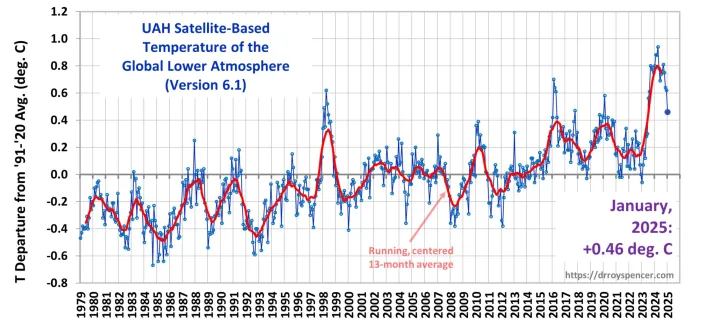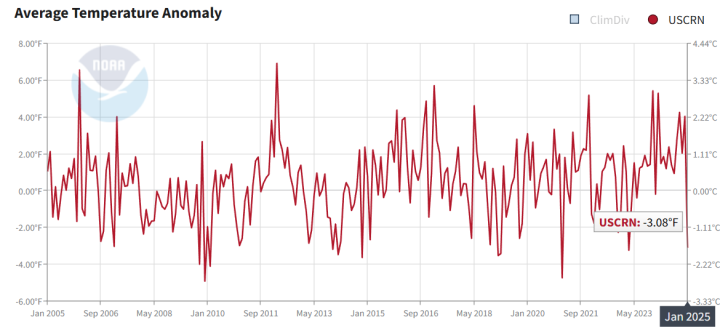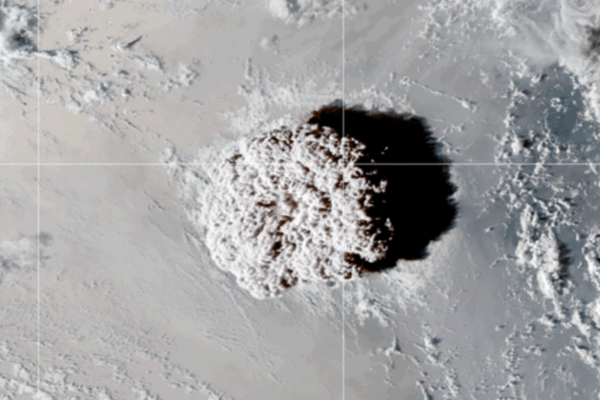One of the largest recorded underwater volcanic eruptions (Jan 15, 2022) sent record amounts of water vapor into the Earth’s atmosphere. As the single biggest driver of warming (water vapor), the Earth’s surface was expected to heat up a bit in and for a while in the following months. The problem was that most of the media and the “scientific community” never mentioned Hunga Tonga’s likely impact, preferring the usual pearl-clutching, apocalyptic prognostications that lead to more and larger government grants to study your lifestyle’s alleged effects on earth.
Ozone depletion was a real concern, but at the end of the day, any rise in average temperature would be your fault.
It’s been there years and a bit, and the greenwashers have been relentless in their caterwauling about any warming, but something is happening that doesn’t fit their narrative. The average global temperature is coming back down while the US just experienced its second steepest one-month drop in over a decade. That’s weather, not climate, unless the weather is warmer.
After years of flat or declining global averages, not long after the 2022 eruption of Hunga Tonga, the UAH Global readings spiked hockey stick hard.

We told you so’s were in abundance despite the obvious cause which is equally relevant to what’s happening now. Global temps have started settling down and appear to be drifting back toward their previous trend. It will take another year or two of readings to see if that water vapor has worked it’s way out of the climate system but the change is notable.
If global CO2 were, in fact, capable of accumulating to a tipping point (it’s not), this would be unlikely, if not simply inexplicable.
More locally, the US Climate Reference Network, a series of 114 temperature tracking stations across the United States – cited away from urban heat islands –just suffered “the 2nd biggest month-to-month temperature drop in the surface temperature record...”
According to the latest NCEI report, January 2025 clocked in at a chilly 29.2°F for the contiguous U.S., already 0.9°F below the long-term average and the coldest January in the USCRN’s 20-year record. Not exactly the “scorching” narrative we’ve been sold.
Fast forward to February 2025, and preliminary data (as of February 20) shows a jaw-dropping slide. While the full month’s numbers are still trickling in, the month-to-month drop from January’s 29.2°F is shaping up to be a whopper—second only to the 2009 late-year nosedive. Back then, temperatures crashed by nearly 8°F between November and December, a seasonal anomaly that raised eyebrows but didn’t fit the warming script, so it quietly faded from the spotlight. This time, early indications suggest a plunge approaching 7°F or more, a rare event in a dataset designed for stability and precision.

I’ll admit to not having seen too many (as in any) stories about last month being the coldest January “on record,” even if is nothing more than the chilliest in the 20-year’s USCRN has been collecting data. It’s obviously the coldest in recent memory, including the milder winters we had prior to the Jan 2022 Eruption. And that doesn’t mean a hell of a lot, either. There will always be colder and warmer “January’s” across many millennia, which is why we make fun of ‘Hottes’ or ‘Coldest’ because saying “on record” is a climate cult buzzword just like “expert” and “consensus,” meant to move hearts, minds, and grant money.
For four decades, the hockey stick people have been losing their minds, preaching the end of days and giving generations of youth climate anxiety but a few of them appear to have had second thoughts about what they’ve been told compared to real-world “today” priorities. Food, housing, some semblance of an affordable lifestyle. A lot more youth are swinging toward the prosperity envisioned by the MAGA movement which is pro-energy.
The Atlantic blames it on COVID, claiming pandemics erode faith in science. This argument is surrounded by surveys, data, and observations about the world (inflation, lockdowns, etc.), but it never gives the proper answer—probably because it doesn’t dare. The article admits that people, and youth in particular, have less faith in government and institutions than in recent memory, but not that those experts and institutions lied to them endlessly.
That level of domestic terrorism could give global warming a sliver of a patina of legitimacy, but much like the rest of the left’s agenda, if you look at the real world, the lies become apparent. You can’t trust their experts or the media that props them up.
There is some good news for the climate cult’s extreme weather enthusiasts. If the poles are significantly cooler than the tropics this summer and Honga Tunga’s warming impact has ended while we won’t get iceless poles – quite the contrary – we could have more hurricanes, stronger ones, and more landfalls.
That has nothing to do with you, but that’s what they’ll claim.
